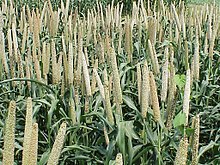
Back Manna (graan) Afrikaans Hirse ALS Millo AN دخن Arabic Miyu AST داری AZB Тары Bashkir Brein BAR Просо Bulgarian মিলেট Bengali/Bangla




Millets (/ˈmɪlɪts/)[1] are a highly varied group of small-seeded grasses, widely grown around the world as cereal crops or grains for fodder and human food. Most species generally referred to as millets belong to the tribe Paniceae.
Millets are important crops in the semiarid tropics of Asia and Africa (especially in India, Mali, Nigeria, and Niger), with 97% of millet production in developing countries.[2] This crop is favored due to its productivity and short growing season under dry, high-temperature conditions.
The term millet is sometimes understood to comprise sorghum. The annual harvest of sorghum is twice the amount of other millets.[citation needed] Of these pearl millet is the most common. Pearl millet and sorghum are important crops in India and parts of Africa.[3] Finger millet, proso millet, and foxtail millet are also important crop species.
Millets may have been consumed by humans for about 7,000 years and potentially had "a pivotal role in the rise of multi-crop agriculture and settled farming societies."[4]
- ^ "Definition of millet". Oxford Dictionaries. Oxford University. Retrieved 21 July 2017.
- ^ McDonough, Cassandrea M.; Rooney, Lloyd W.; Serna-Saldivar, Sergio O. (2000). "The Millets". Food Science and Technology: Handbook of Cereal Science and Technology. 99 2nd ed. CRC Press: 177–210.
- ^ "Annex II: Relative importance of millet species, 1992–94". The World Sorghum and Millet Economies: Facts, Trends and Outlook. Food and Agriculture Organization of the United Nations. 1996. ISBN 978-92-5-103861-1.
- ^ Cherfas, Jeremy (23 December 2015). "Millet: How A Trendy Ancient Grain Turned Nomads Into Farmers". National Public Radio. The Salt. Retrieved 4 May 2018.
© MMXXIII Rich X Search. We shall prevail. All rights reserved. Rich X Search